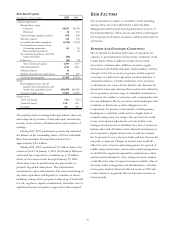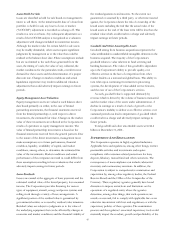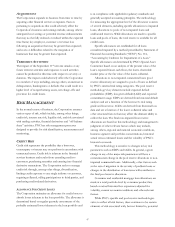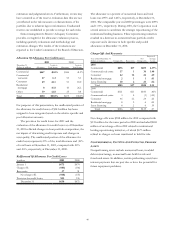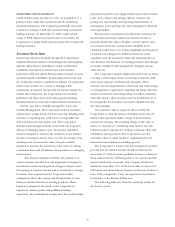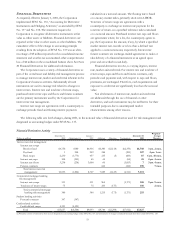PNC Bank 2001 Annual Report Download - page 47
Download and view the complete annual report
Please find page 47 of the 2001 PNC Bank annual report below. You can navigate through the pages in the report by either clicking on the pages listed below, or by using the keyword search tool below to find specific information within the annual report.45
Loans Held For Sale
Loans are classified as held for sale based on management’s
intent to sell them. At the initial transfer date of a loan from
portfolio to held for sale, any lower of cost or market
(“LOCOM”) adjustment is recorded as a charge-off. This
results in a new cost basis. Any subsequent adjustment as a
result of the LOCOM analysis is recognized as a valuation
adjustment with changes included in noninterest income.
Although the market value for certain held for sale assets
may be readily obtainable, other assets require significant
judgments by management as to the value that could be
realized at the balance sheet date. These assumptions include
but are not limited to the cash flows generated from the
asset, the timing of a sale, the value of any collateral, the
market conditions for the particular credit, overall investor
demand for these assets and the determination of a proper
discount rate. Changes in market conditions and actual
liquidation experience may result in additional valuation
adjustments that could adversely impact earnings in future
periods.
Equity Management Asset Valuation
Equity management assets are valued at each balance sheet
date based primarily on either, in the case of limited
partnership investments, the financial statements received
from the limited partnership or, with respect to direct
investments, the estimated fair value. Changes in the market
value of these investments are reflected in the Corporation’s
results of operations as equity management income. The
value of limited partnership investments is based on the
financial statements received from the general partners. Due
to the nature of the direct investments, management must
make assumptions as to future performance, financial
condition, liquidity, availability of capital, and market
conditions, among others, to determine the estimated fair
value of the investments. Market conditions and actual
performance of the companies invested in could differ from
these assumptions resulting in lower valuations that could
adversely impact earnings in future periods.
Lease Residuals
Leases are carried at the aggregate of lease payments and the
estimated residual value of the leased property, less unearned
income. The Corporation provides financing for various
types of equipment, aircraft, energy and power systems and
rolling stock through a variety of lease arrangements. A
significant portion of the residual value is guaranteed by
governmental entities or covered by residual value insurance.
Residual values are subject to judgments as to the value of
the underlying equipment that can be affected by changes in
economic and market conditions and the financial viability of
the residual guarantors and insurers. To the extent not
guaranteed or assumed by a third party, or otherwise insured
against, the Corporation bears the risk of ownership of the
leased assets including the risk that the actual value of the
leased assets at the end of the lease term will be less than the
residual value which could result in a charge and adversely
impact earnings in future periods.
Goodwill And Other Amortizable Assets
Goodwill arising from business acquisitions represents the
value attributable to unidentifiable intangible elements in the
business acquired. The majority of the Corporation’s
goodwill relates to value inherent in fund servicing and
banking businesses. The value of this goodwill is dependent
upon the Corporation’s ability to provide quality, cost
effective services in the face of competition from other
market leaders on a national and global basis. This ability in
turn relies upon continuing investments in processing
systems, the development of value-added service features,
and the ease of use of the Corporation’s services.
As such, goodwill value is supported ultimately by
revenue which is driven by the volume of business transacted
and the market value of the assets under administration. A
decline in earnings as a result of a lack of growth or the
Corporation’s inability to deliver cost effective services over
sustained periods can lead to impairment of goodwill which
could result in a charge and adversely impact earnings in
future periods.
Total goodwill and other amortizable assets were $2.4
billion at December 31, 2001.
SUPERVISION AND REGULATION
The Corporation operates in highly regulated industries.
Applicable laws and regulations, among other things, restrict
permissible activities and investments and require
compliance with consumer-related protections for loan,
deposit, fiduciary, mutual fund and other customers. The
consequences of noncompliance can include substantial
monetary and nonmonetary sanctions. In addition, the
Corporation is subject to comprehensive examination and
supervision by, among other regulatory bodies, the Federal
Reserve Board and the Office of the Comptroller of the
Currency. These regulatory agencies generally have broad
discretion to impose restrictions and limitations on the
operations of a regulated entity where the agencies
determine, among other things, that such operations are
unsafe or unsound, fail to comply with applicable law or are
otherwise inconsistent with laws and regulations or with the
supervisory policies of these agencies. The examination
process and the regulators’ associated supervisory tools could
materially impact the conduct, growth and profitability of the










